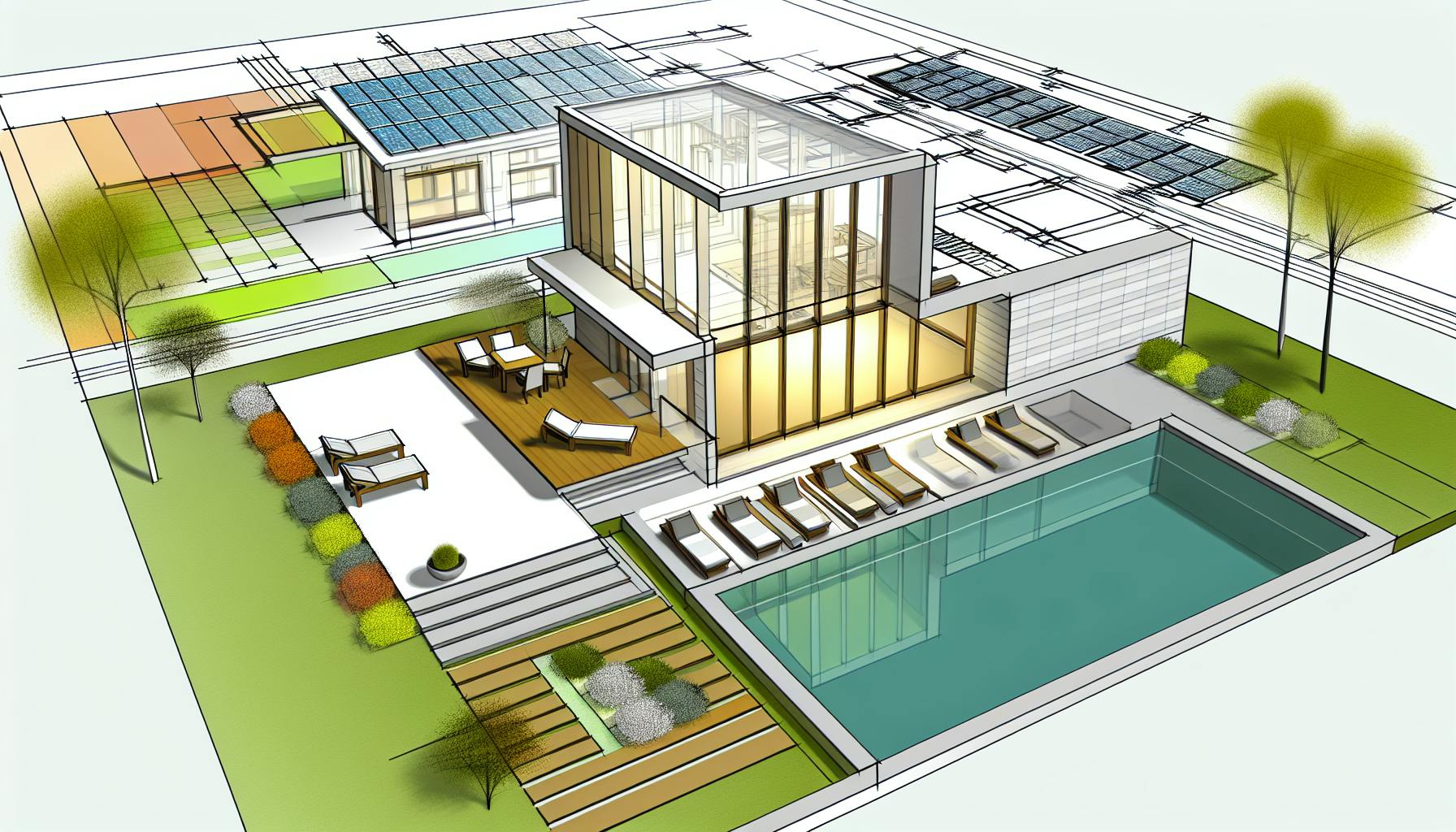Small wood houses are compact, eco-friendly homes typically under 400 square feet. Here's what you need to know:
- Blend charm with modern living
- Cost-effective, starting around £48,000
- Naturally regulate temperature, reducing energy bills
- Create healthy living spaces by balancing humidity
- Quick to build and cheap to maintain
- Can improve mood and lower blood pressure
Key features:
- Architectural styles: Modern Farmhouse, Craftsman Bungalow, Scandinavian Timber Frame, Japanese Minimalist, Cape Cod Compact
- Space optimization: Stairs as storage, wall-mounted units, multi-functional furniture
- Sustainability: Solar power, recycled materials, water-saving systems, natural temperature control
- Contemporary design: Large windows, statement lighting, mixed materials, textured surfaces
Small wood houses cut energy use by 45% compared to traditional homes. They offer a practical path to green living without sacrificing style or comfort.
Related video from YouTube
1. Architectural Styles
Let's dive into five architectural styles that have made their mark on modern small wood houses. Each style brings something special to the table, catering to different ways of living.
Modern Farmhouse
This style mixes old-school charm with new-age comfort. You'll find open floor plans and reclaimed wood beams. But the star of the show? A big wrap-around porch that blurs the line between inside and outside living. It's no wonder this style's been climbing the popularity charts lately.
Craftsman Bungalow
Born between 1900 and 1929, this style is all about handmade details and natural materials. Picture built-in furniture, massive fireplaces, and chunky square porch columns. The floor plans? They're open and flowing, making the most of every inch.
Scandinavian Timber Frame
This style uses big solid posts and beams, held together with wooden pegs. It's like a game of Jenga, but way more stable. The cool part? You can play around with the inside layout because there are no pesky load-bearing walls. Check out the Base Cabin series by Shelby Lenehan - they've got these slanted ceilings that make small spaces feel huge.
Japanese Minimalist
Think simple lines and flexible spaces that vibe with nature. Sliding doors and low, built-in seating keep things clean and clutter-free. Want to see it in action? Look at Fritz Tiny Homes' Halcyon design. It's just 28 feet long, but those clean lines and big windows make it feel spacious.
Cape Cod Compact
This style's got history - English settlers brought it over way back when. It's all about symmetry: matching windows with a door right in the middle. But don't think it's stuck in the past. Modern versions, like Nordic & Spruce's "The Weekender" series, mix old-school charm with new tricks like white-washed interiors and black metal accents.
"Not so Big, Small House Plans, and Tiny Houses are a clarion call to sanity and responsibility in home ownership as opposed to the 'Bigger is Better' mentality."
Each of these styles has its own way of making small spaces work hard and look good. The trick is finding the one that fits your life and your taste. It's not about picking the trendiest option - it's about choosing a home that feels right for you.
2. Space Optimization
Tiny homes demand clever storage solutions. Here's how to make the most of every inch:
Turn Stairs into Storage
Paradise Tiny Homes shows us how to transform stairs into pull-out drawers and shelves. It's a smart way to add storage without eating up living space.
Use Those Walls
Don't let vertical space go to waste. Sim-Plex Design Studio's Izakaya House is a great example. They use floating shelves and corner units to create storage that looks good and doesn't clutter the room.
Furniture That Does Double Duty
Architect Tomoko Sasaki likes to blur the lines between furniture and architecture. Take Tru Form Tiny's elevator bed design. During the day, it folds up to reveal a desk underneath. One space, two uses.
Kitchen Tricks
Make your kitchen work harder with pull-out cabinets and corner units with lazy susans. Summit Tiny Homes shows how a bar top can be both a dining area and a workspace. No need for a separate home office.
Bathroom Hacks
No linen closet? No problem. @sincewewokeup rolls towels instead of stacking them to save space. Throw in some over-the-door organizers for toiletries, and you're all set.
"What I learned in early investigations is that I wanted to preserve the verticality of space." - Christoph Kaiser, Architect
These ideas aren't just theory. Monica Chang's 170-square-foot garage conversion puts them into practice. The result? A tiny home that feels surprisingly roomy.
Smart design can make even the smallest wood houses feel like home. It's all about using space wisely and making every square foot count.
sbb-itb-1be9014
3. Sustainability Features
Small wood houses are perfect for eco-friendly living. Let's look at five ways these homes help the environment:
Solar Power Tiny homes are going solar. With LED lights that use 90% less power than old bulbs and well-placed solar panels, these small spaces can run entirely on sun power. Take the Villa Circuitus - it shows how you can live off-grid with smart energy use.
Smart Materials Using old wood isn't just cool - it's game-changing. Local, recycled stuff cuts down on carbon big time. United Tiny Homes says pre-made panels build faster and waste less. They also use natural sealants and paints that don't mess with your air.
Saving Water Clever plumbing makes a huge difference. Composting toilets use no water at all. Grey water systems can cut daily water use by 40%. And low-flow taps and showers save water without losing function.
Natural Temperature Control Good insulation and smart window placement keep things comfy. Double-glazed windows stop heat escaping, while passive solar design soaks up winter sun and blocks summer heat. As Jorge Fontan puts it:
"If you want to build a sustainable house, you need to build it to last."
Green Heating Bioethanol fuel is a clean way to heat. It only makes water vapor and CO2, which nearby plants soak up. Mix that with good insulation like sheep's wool or recycled cotton, and you'll stay warm without hurting the planet.
United Tiny Homes sums it up:
"Building your eco-friendly tiny house is more than just a trend; it's a lifestyle choice that champions sustainability and minimalism."
These features don't just help the planet - they save you cash too. Energy-efficient appliances and smart design can slash your bills. The average American homeowner pays $400 a month for utilities. In a tiny house? Way less.
4. Contemporary Design Elements
Today's small wood houses mix natural warmth with sleek design. Let's look at five key features shaping modern wooden homes:
Bringing Nature Inside
Big windows let in tons of light, making it feel like you're outdoors even when you're inside. Ginger Curtis from Urbanology Designs puts it this way:
"This trend centers around bringing the outdoors inside, creating spaces that foster a stronger connection with nature."
Eye-Catching Lights
Cool lighting can transform a small wooden space. Curtis says:
"Lighting trends will become a key player, with sculptural pendant lights, oversized chandeliers and artistic floor lamps stealing the spotlight."
These lights add drama but keep things cozy.
Mixing Materials
New wooden houses mix things up. Raw wood meets industrial stuff like steel beams. It looks pretty cool. Sarah Barnard, a WELL and LEED certified designer, explains:
"Natural wood finishes create warmth within our homes by showcasing woodgrain's tone and beauty."
Groovy Textures
Fluted wood (that's wood with grooves) adds texture to walls and cabinets. Barnard notes:
"Fluting's understated, curved features add to the aesthetic unobtrusively."
It makes things interesting without being too much for small spaces.
Smart Color Choices
Modern wood homes use the 60/30/10 rule for wood colors:
- 60% main color
- 30% second color
- 10% accent color
This adds depth but keeps things open. And get this: 82% of people say they're happier when surrounded by different wood elements. That's a lot of happy people!
Conclusion
Small wood houses aren't just trendy - they're a smart choice for modern living. These tiny homes (usually under 400 square feet) pack a big environmental punch. People who move to these smaller spaces cut their energy use by 45%. That's a huge win for the planet.
What makes these little wooden wonders so great? They're flexible and efficient. Wood naturally insulates well, keeping you comfy while saving on energy bills. As Jonite® puts it:
"Dwelling in an environmentally friendly home not only brings about sustainability on the building itself but also finds its way to integrate with the residents' lifestyle."
The environmental perks are impressive. Regular building materials eat up about 16% of yearly fossil fuels. But wooden homes? They need way less energy to make and build. Plus, they actually store carbon, helping to fight climate change.
Don't think "small" means "worse." Just ask George Bierman, who owns a log home:
"Many of my close friends who visit me at my cabin tell me that when I'm there, I'm a different person."
Small wood houses are shaping the future of housing. They mix clever design, eco-friendliness, and modern comfort - all while keeping you close to nature. Maybe you're an empty nester looking to simplify. Or you want to shrink your carbon footprint. Either way, these homes offer a practical path to green living without sacrificing style or comfort.


